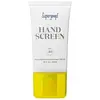What's inside
What's inside
 Key Ingredients
Key Ingredients

 Benefits
Benefits

 Concerns
Concerns

 Ingredients Side-by-side
Ingredients Side-by-side

Water
Skin ConditioningCyclopentasiloxane
EmollientButylene Glycol
HumectantGlycerin
HumectantDicaprylyl Carbonate
EmollientPropylene Glycol Dicaprylate
EmollientDisiloxane
Skin ConditioningDimethicone/Vinyl Dimethicone Crosspolymer
Skin ConditioningDimethicone
EmollientPEG-10 Dimethicone
Skin ConditioningSodium Acrylates Crosspolymer-2
AbsorbentPolymethylsilsesquioxane
Butyloctyl Salicylate
Skin ConditioningVinyl Dimethicone/Methicone Silsesquioxane Crosspolymer
Vaccinium Angustifolium Fruit Extract
Skin ProtectingOenothera Biennis Flower Extract
AstringentEuterpe Oleracea Fruit Extract
Hibiscus Sabdariffa Flower Extract
Skin ConditioningCamellia Sinensis Leaf Extract
AntimicrobialPinus Palustris Leaf Extract
TonicUlmus Davidiana Root Extract
Skin ConditioningPueraria Lobata Root Extract
HumectantEnantia Chlorantha Bark Extract
Skin ConditioningLavandula Angustifolia Oil
MaskingRosa Canina Fruit Oil
EmollientAnthemis Nobilis Flower Oil
MaskingSodium Hyaluronate
HumectantOleanolic Acid
Skin ConditioningSqualane
EmollientGlyceryl Caprylate
EmollientAluminum Hydroxide
EmollientPolyglyceryl-6 Polyricinoleate
EmulsifyingSorbitan Caprylate
EmulsifyingStearic Acid
CleansingSynthetic Fluorphlogopite
Triethoxycaprylylsilane
Dipropylene Glycol
Humectant1,2-Hexanediol
Skin ConditioningDimethicone/PEG-10/15 Crosspolymer
Disteardimonium Hectorite
StabilisingMagnesium Sulfate
Ethylhexylglycerin
Skin ConditioningIron Oxides
Water, Cyclopentasiloxane, Butylene Glycol, Glycerin, Dicaprylyl Carbonate, Propylene Glycol Dicaprylate, Disiloxane, Dimethicone/Vinyl Dimethicone Crosspolymer, Dimethicone, PEG-10 Dimethicone, Sodium Acrylates Crosspolymer-2, Polymethylsilsesquioxane, Butyloctyl Salicylate, Vinyl Dimethicone/Methicone Silsesquioxane Crosspolymer, Vaccinium Angustifolium Fruit Extract, Oenothera Biennis Flower Extract, Euterpe Oleracea Fruit Extract, Hibiscus Sabdariffa Flower Extract, Camellia Sinensis Leaf Extract, Pinus Palustris Leaf Extract, Ulmus Davidiana Root Extract, Pueraria Lobata Root Extract, Enantia Chlorantha Bark Extract, Lavandula Angustifolia Oil, Rosa Canina Fruit Oil, Anthemis Nobilis Flower Oil, Sodium Hyaluronate, Oleanolic Acid, Squalane, Glyceryl Caprylate, Aluminum Hydroxide, Polyglyceryl-6 Polyricinoleate, Sorbitan Caprylate, Stearic Acid, Synthetic Fluorphlogopite, Triethoxycaprylylsilane, Dipropylene Glycol, 1,2-Hexanediol, Dimethicone/PEG-10/15 Crosspolymer, Disteardimonium Hectorite, Magnesium Sulfate, Ethylhexylglycerin, Iron Oxides
Butyl Methoxydibenzoylmethane 3%
UV AbsorberEthylhexyl Salicylate 5%
UV AbsorberOctocrylene 10%
UV AbsorberWater
Skin ConditioningGlycerin
HumectantButyloctyl Salicylate
Skin ConditioningC12-15 Alkyl Benzoate
AntimicrobialCetearyl Alcohol
EmollientPropanediol
SolventGlyceryl Stearate Citrate
EmollientCocoglycerides
EmollientIsododecane
EmollientCetyl Esters
EmollientCetyl Phosphate
EmulsifyingDiisopropyl Sebacate
EmollientIsodecyl Neopentanoate
EmollientLauryl Lactate
EmollientArginine
Masking1,2-Hexanediol
Skin ConditioningCaprylyl Glycol
EmollientHydroxyacetophenone
AntioxidantPolymethylsilsesquioxane
Raphanus Sativus Seed Oil
EmollientDiethylhexyl Syringylidenemalonate
Skin ProtectingHelianthus Annuus Seed Wax
Skin ConditioningLimnanthes Alba Seed Oil
Skin ConditioningAcrylates/C10-30 Alkyl Acrylate Crosspolymer
Emulsion StabilisingChlorphenesin
AntimicrobialXanthan Gum
EmulsifyingTrisodium Ethylenediamine Disuccinate
Argania Spinosa Kernel Oil
EmollientCaprylic/Capric Triglyceride
MaskingCitrus Nobilis Peel Oil
MaskingPlantago Lanceolata Leaf Extract
AntimicrobialGlycine Soja Oil
EmollientTocopherol
AntioxidantCymbopogon Schoenanthus Oil
MaskingHippophae Rhamnoides Fruit Oil
Skin ProtectingElettaria Cardamomum Seed Oil
MaskingEugenia Caryophyllus Leaf Oil
MaskingCinnamomum Cassia Leaf Oil
MaskingVanillin
MaskingEucalyptus Globulus Leaf Oil
PerfumingLavandula Hybrida Grosso Herb Oil
PerfumingButyl Methoxydibenzoylmethane 3%, Ethylhexyl Salicylate 5%, Octocrylene 10%, Water, Glycerin, Butyloctyl Salicylate, C12-15 Alkyl Benzoate, Cetearyl Alcohol, Propanediol, Glyceryl Stearate Citrate, Cocoglycerides, Isododecane, Cetyl Esters, Cetyl Phosphate, Diisopropyl Sebacate, Isodecyl Neopentanoate, Lauryl Lactate, Arginine, 1,2-Hexanediol, Caprylyl Glycol, Hydroxyacetophenone, Polymethylsilsesquioxane, Raphanus Sativus Seed Oil, Diethylhexyl Syringylidenemalonate, Helianthus Annuus Seed Wax, Limnanthes Alba Seed Oil, Acrylates/C10-30 Alkyl Acrylate Crosspolymer, Chlorphenesin, Xanthan Gum, Trisodium Ethylenediamine Disuccinate, Argania Spinosa Kernel Oil, Caprylic/Capric Triglyceride, Citrus Nobilis Peel Oil, Plantago Lanceolata Leaf Extract, Glycine Soja Oil, Tocopherol, Cymbopogon Schoenanthus Oil, Hippophae Rhamnoides Fruit Oil, Elettaria Cardamomum Seed Oil, Eugenia Caryophyllus Leaf Oil, Cinnamomum Cassia Leaf Oil, Vanillin, Eucalyptus Globulus Leaf Oil, Lavandula Hybrida Grosso Herb Oil
 Reviews
Reviews

Ingredients Explained
These ingredients are found in both products.
Ingredients higher up in an ingredient list are typically present in a larger amount.
1,2-Hexanediol is a synthetic liquid and another multi-functional powerhouse.
It is a:
- Humectant, drawing moisture into the skin
- Emollient, helping to soften skin
- Solvent, dispersing and stabilizing formulas
- Preservative booster, enhancing the antimicrobial activity of other preservatives
Butyloctyl Salicylate is a chemical UV filter structurally similar to octisalate. It is a photostabilizer, SPF booster, emollient and solvent. This ingredient helps evenly spread out ingredients.
According to a manufacturer, it is suitable for pairing with micro Titanium Dioxide, Zinc Oxide, and pigments.
Photostabilizers help stabilize UV-filters and prevents them from degrading quickly.
Learn more about Butyloctyl SalicylateGlycerin is already naturally found in your skin. It helps moisturize and protect your skin.
A study from 2016 found glycerin to be more effective as a humectant than AHAs and hyaluronic acid.
As a humectant, it helps the skin stay hydrated by pulling moisture to your skin. The low molecular weight of glycerin allows it to pull moisture into the deeper layers of your skin.
Hydrated skin improves your skin barrier; Your skin barrier helps protect against irritants and bacteria.
Glycerin has also been found to have antimicrobial and antiviral properties. Due to these properties, glycerin is often used in wound and burn treatments.
In cosmetics, glycerin is usually derived from plants such as soybean or palm. However, it can also be sourced from animals, such as tallow or animal fat.
This ingredient is organic, colorless, odorless, and non-toxic.
Glycerin is the name for this ingredient in American English. British English uses Glycerol/Glycerine.
Learn more about GlycerinPolymethylsilsesquioxane is a silicone used as a film forming agent.
When applied to the skin, this ingredient creates an invisible film on the surface. This film still allows oxygen to pass through, but prevents moisture from escaping. This can help condition and hydrate the skin. It also leaves a silky feel when applied.
Polymethylsilsesquioxane has not been shown to clog pores. It has been deemed safe to use up to 55%, but most cosmetics use much less.
If you have concerns about using this ingredient, we recommend speaking with a professional.
Learn more about PolymethylsilsesquioxaneWater. It's the most common cosmetic ingredient of all. You'll usually see it at the top of ingredient lists, meaning that it makes up the largest part of the product.
So why is it so popular? Water most often acts as a solvent - this means that it helps dissolve other ingredients into the formulation.
You'll also recognize water as that liquid we all need to stay alive. If you see this, drink a glass of water. Stay hydrated!
Learn more about Water